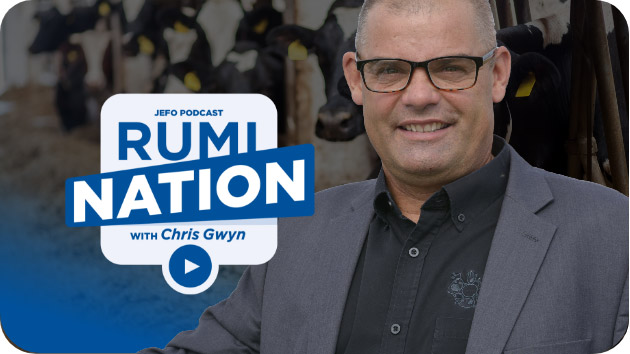RumiNation | S05 : E16
Impact of Stocking Density on Milk Production and Profitability
Brought to you by Jefo Nutrition
Share now!
Did you enjoy this episode?
Share now!
Impact of Stocking Density on Milk Production and Profitability
Dr. Albert De Vries discusses the complexities of stocking density in dairy, highlighting economic principles, the linear relationship between overstocking and cow losses, and the importance of careful calculations for optimal outcomes.
Our guest - Dr. Albert De Vries
Albert De Vries is currently a professor in the Department of Animal Sciences at the University of Florida. He went to Wageningen University where he received a BS and MS in Animal Science with a minor in agricultural economics in 1991. In 1995, he came to the US to pursue a Ph.D. in Animal Sciences at the University of Minnesota in St. Paul with a focus on dairy science, applied economics, operations research, and statistics.

Timestamps & Summary
Chris Gwyn (02:11)
I’d like to know a little more about why you became interested in researching ideal topic density.
Dr. Albert De Vries
I actually had an intern student from the Netherlands, and that student was very interested in welfare. And I said: If we just do welfare in the US, maybe that’s not of primary interest to producers, although I understand our producers are all interested in welfare aspects as well. But I’d like to put dollars into whatever we do with cows. And so we did a little digging and came up on the topic of stocking density, the economics of stocking density. It’s really a fascinating topic because there are some welfare implications but there are clearly also economic implications. […]
Chris Gwyn (03:23)
What are the key influencers of the economic return when you’re evaluating where a farm is evaluating its optimal stocking density?
Dr. Albert De Vries
I think we should start by defining, what we mean by stocking density. Different metrics of that. We’re not talking about dry lots here. We’re talking about free stalls. We were also not interested in fresh cows or dry cows, which I think all experts agree should not be overstocked. We’re looking at lactating cows. And we also did not think that feed bunk space was a limiting factor. So, in our research, we really looked at the number of cows over the number of stalls in a pen. And if that is 100%, then you have one stall per cow. And if it’s like 120%, you have 120 cows for 100 stalls. So that is where we sort of limited our research to. And secondly, I think it’s important to get the economic principle right. What are we trying to optimize here when we’re talking about economics? […]
Chris Gwyn (11:20)
In that study, you looked at milk production. Did you look at component yield?
Dr. Albert De Vries
I think we looked at component yield, but I don’t remember seeing anything necessarily, because, of course, we get paid for components. I don’t think it was very clear that either fat or protein, for example, was reduced by overstocking.
Chris Gwyn (14:10)
If there are some other issues that you wanted […] to highlight, we can do that.
Dr. Albert De Vries
I haven’t really said much about welfare yet. I mean, the student I work with was really interested in that, and I think it needs to be on our minds, too. So, if we say we just want to take care of the cow, we probably don’t want to overstock. Cows are probably compromising welfare, perhaps a tiny bit only if we start to overstock, and more when we overstock more. So, we don’t know how to square that with profitability. But obviously, that needs to be in our mind as well. […]
Chris Gwyn (16:34)
Can I ask you a further question about that? Because I’m not an economist, but where does cash flow come in if a farm needs to increase cash flow? Does that kind of counter go against optimal stocking density in low milk pricing?
Dr. Albert De Vries
I think you’re on the right track there because we assume our fixed costs are independent of the number of cows. So, we would add cows to it up to the point of maximum optimal stocking density, which implies that, for that pen, the highest cash flow. And so, with low milk prices, we reduce cow numbers, because if we don’t, our cash flow is going to be even less. So, cash flows, in this analysis, and this is obviously what I call a steady state; we sort of permanently are at a high or a low level of stocking density, but it’s the same thing. So, the question becomes practically different: Well, my milk prices change, and I may or may not have the cows. What is the long-term response to stocking density? Those are harder to answer because, again, we don’t know the long-term response to stocking density per se, but essentially, when we optimize our stocking density, we’re optimizing the cash flow, the amount of cash made there for that pen on that day over time.
Chris Gwyn (20:40)
As we wind up, I always like to ask, what are some of the key take-home points for producers and nutritionists and lenders, in fact, and veterinarians, when considering evaluating the impact of a stocking density on the farms they work with, what would you recommend they look at?
Dr. Albert De Vries
If I put on my economics glasses, if you will, then I think overstocking a pace. And like last year in the US, we had actually good milk prices. […] At the same time, we learned through the research that it sort of is farm-dependent in terms of prices and what are the losses that you observe. And so we have a spreadsheet available for listeners that they can work with, and play with. Probably the easiest way to get there. If you go to Google and you look for “dairy stocking density calculator Florida”, I think we end up number one on the Google search list there. And there’s an EDI extension publication there. And that publication lays out what the research was about, hopefully in not too scientific terms. And there’s a link to a calculator we used as well that we made available for folks to play with. […]







